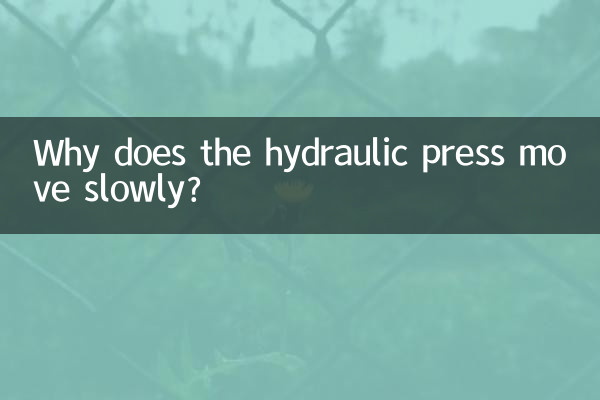Why does the hydraulic press move slowly?
Hydraulic press is a commonly used equipment in modern industrial production and is highly favored for its efficient and stable performance. However, in actual use, the problem of slow hydraulic press movement often occurs, which not only affects production efficiency, but may also hide equipment failures. This article will analyze the common causes of slow hydraulic movement and provide corresponding solutions.
1. Common causes of slow hydraulic movement

Slow movement of the hydraulic press may be caused by many factors. The following are common reasons:
| Cause classification | Specific performance | possible impact |
|---|---|---|
| Hydraulic oil problem | Oil contamination, insufficient oil volume, too high oil temperature | Insufficient system pressure and slow movement |
| Pump or valve failure | Pump wear, valve core stuck | Abnormal flow or pressure |
| Pipeline problem | Leakage, blockage | Large pressure loss |
| Actuator failure | Internal leakage of oil cylinder and damaged seals | Weak or slow movements |
| control system issues | Signal delay and improper parameter settings | Slow response |
2. Detailed analysis and solutions
1. Hydraulic oil problem
Hydraulic oil is the "blood" of the hydraulic system, and its state directly affects the performance of the equipment. Oil contamination will cause the valve core to stick and the filter element to become clogged; insufficient oil will cause the pump to be empty; oil temperature that is too high will reduce the oil viscosity and increase internal leakage. It is recommended to check the oil level and cleanliness regularly and replace the hydraulic oil on time.
2. Pump or valve failure
Wear of the hydraulic pump will cause the flow rate to decrease, and the stuck control valve will affect the action response. The performance of the pump can be judged through pressure testing, and faulty valves can be disassembled, inspected, cleaned or replaced. Note: The working environment should be kept clean during maintenance.
3. Pipeline problems
Pipe leaks not only cause pressure loss, but also pose safety hazards; pipeline blockages can limit flow. Pipe connections should be checked regularly, filters should be cleaned, and aging pipes should be replaced if necessary.
4. Actuator failure
Internal leakage in the cylinder will cause insufficient thrust, and damaged seals will cause slow action. The sealing performance of the oil cylinder can be judged through the pressure holding test, and damaged seals can be replaced in time.
5. Control system issues
Electrical signal delays and improper PLC parameter settings may cause slow movement. Sensors and line connections should be checked, and system parameter settings should be checked.
3. Maintenance suggestions
In order to prevent the hydraulic machine from moving slowly, it is recommended to establish the following maintenance system:
| maintenance items | cycle | Check content |
|---|---|---|
| Hydraulic oil inspection | daily | Oil level, appearance |
| Filter check | weekly | Blockage |
| System stress test | monthly | Pressure value for each working condition |
| Comprehensive overhaul | every year | All hydraulic components |
4. Typical case analysis
A 200-ton hydraulic press in a factory moved slowly. After inspection, it was found that:
- Hydraulic oil is milky white (moisture contamination)
- The main pump outlet pressure is only 70% of the rated value
- The directional valve spool is slightly stuck
Treatment measures: replace the hydraulic oil and filter element, overhaul the hydraulic pump, and clean the directional valve. The device returned to normal after treatment.
5. Summary
Slow movement of a hydraulic machine is usually an external manifestation of a system problem, which needs to be investigated from various aspects such as hydraulic oil, components, pipelines, and controls. Establishing a standardized maintenance system can effectively prevent such failures. When encountering complex problems, it is recommended to contact professional maintenance personnel.
From the above analysis, it can be seen that keeping the hydraulic system clean and conducting regular maintenance and inspections is the key to ensuring efficient operation of the equipment. Operators should be familiar with equipment performance parameters and detect and handle abnormal situations in a timely manner.

check the details

check the details